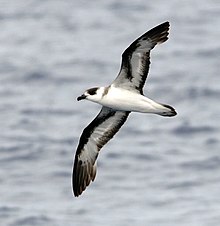This is an old revision of this page, as edited by YFdyh-bot (talk | contribs) at 08:03, 3 February 2013 (r2.7.3) (Robot: Adding vi:Pterodroma). The present address (URL) is a permanent link to this revision, which may differ significantly from the current revision.
Revision as of 08:03, 3 February 2013 by YFdyh-bot (talk | contribs) (r2.7.3) (Robot: Adding vi:Pterodroma)(diff) ← Previous revision | Latest revision (diff) | Newer revision → (diff)
| Gadfly Petrels | |
|---|---|

| |
| Black-capped Petrel | |
| Scientific classification | |
| Kingdom: | Animalia |
| Phylum: | Chordata |
| Class: | Aves |
| Subclass: | Neornithes |
| Infraclass: | Neoaves |
| Order: | Procellariiformes |
| Family: | Procellariidae |
| Genus: | Pterodroma Bonaparte, 1856 |
| Species | |
|
About 35, see text. | |
| Diversity | |
| ] | |
The gadfly petrels are seabirds in the bird order Procellariiformes. These medium to large petrels feed on food items picked from the ocean surface.
The short, sturdy bills of the Pterodroma species in this group, about 35 altogether, are adapted for soft prey taken at the surface; they have twisted intestines for digesting marine animals which have unusual biochemistries.
Their complex wing and face marking are probably for interspecific recognition.
These birds nest in colonies on islands and are pelagic when not breeding. One white egg is laid usually in a burrow or on open ground. They are nocturnal at the breeding colonies.
Species in taxonomic order
The taxonomy of the gadfly petrels is being reformed at the moment. Several genera have been split off over time, as they are closer to the procellarine and Puffinus shearwaters. Some subspecies have been raised to full species rank. The arrangement given here is traditional, but annotates the changes proposed by Austin (1998) and Bretagnolle et al. (1998). For the current taxonomy, see also Brooke (2004).
- Genus Pterodroma
- Pterodroma baraui, Barau's Petrel
- Pterodroma arminjoniana, Trindade Petrel
- Pterodroma (arminjoniana) heraldica, Herald Petrel – recognized by the IOC. However, the SACC has not recognized the split yet.
Split from Pterodroma arminjoniana
- Pterodroma (arminjoniana) heraldica, Herald Petrel – recognized by the IOC. However, the SACC has not recognized the split yet.
- Pterodroma externa, Juan Fernandez Petrel
- Pterodroma neglecta, Kermadec Petrel
- Pterodroma phaeopygia, Galapagos Petrel
- Pterodroma sandwichensis, Hawaiian Petrel
- Pterodroma atrata, Henderson Petrel
- Pterodroma alba, Phoenix Petrel
- Pterodroma feae, Fea's Petrel
- Pterodroma desertae, Deserta's Petrel (disputed)
- Pterodroma madeira, Zino's Petrel or Madeira Petrel
- Pterodroma sp., Canary Islands Petrel, (prehistoric) – possibly extirpated population of extant species
- Pterodroma mollis, Soft-plumaged Petrel
- Pterodroma cahow, Bermuda Petrel
- Pterodroma hasitata, Black-capped Petrel
- Pterodroma caribbaea, Jamaica Petrel, (possibly extinct)
- Pterodroma incerta, Atlantic Petrel
- Pterodroma lessonii, White-headed Petrel
- Pterodroma magentae, Magenta Petrel
- Pterodroma macroptera, Great-winged Petrel
- Pterodroma solandri, Providence Petrel
- Pterodroma ultima, Murphy's Petrel
- Pterodroma cf. leucoptera, Mangareva Petrel, (possibly extinct)
- Pterodroma cervicalis, White-necked Petrel
- Pterodroma occulta, Vanuatu Petrel or Falla's Petrel
- Split from Pterodroma cervicalis
- Pterodroma sp., Chatham Extinct Petrel, (prehistoric)
- Pterodroma sp., Henderson Island Petrel, (prehistoric)
- Pterodroma jugabilis, O‘ahu Petrel, (prehistoric)
- Pterodroma rupinarum, Large Saint Helena Petrel, (extinct)
- Subgenus Cookilaria
- Pterodroma cookii, Cook's Petrel
- Pterodroma pycrofti, Pycroft's Petrel
- Pterodroma defilippiana, De Filippi's Petrel or Mas a Tierra Petrel
- Pterodroma longirostris, Stejneger's Petrel
- Pterodroma nigripennis, Black-winged Petrel
- Pterodroma axillaris, Chatham Petrel
- Pterodroma hypoleuca, Bonin Petrel
- Pterodroma inexpectata, Mottled Petrel
- Pterodroma leucoptera, Gould's Petrel
- Pterodroma brevipes, Collared Petrel
- Pterodroma brevipes magnificens, may be a full species Magnificent Petrel Pterodroma magnificens
A Pleistocene fossil from Aldabra in the Indian Ocean was described as Pterodroma kurodai. Biogeographically, it could belong into any genus.
Footnotes
- http://www.worldbirdnames.org/updates-PS.html
- Onley, D. & Schofield, P. (2007)
- Pterodroma brevipes magnificens (Bretagnolle & Shirihai, 2010): Banks Islands, Vanuatu. Bull BOC 130(4).
References
- Austin, Jeremy J. (1996): Molecular Phylogenetics of Puffinus Shearwaters: Preliminary Evidence from Mitochondrial Cytochrome b Gene Sequences. Molecular Phylogenetics and Evolution 6(1): 77–88 doi:10.1006/mpev.1996.0060 (HTML abstract)
- Bretagnolle, V., Attié, C., Pasquet, E., (1998) "Cytochrome-B evidence for validity and phylogenetic relationships of Pseudobulweria and Bulweria (Procellariidae)" Auk 115(1):188-195 PDf fulltext
- Brooke, M. (2004): Albatrosses and Petrels Across the World. Oxford University Press, Oxford, UK. ISBN 0-19-850125-0
- Onley, Derek and Paul Scofield (2007) Albatrosses, Petrels and Shearwaters of the World Helm Field Guides ISBN 978-971-36-4332-9